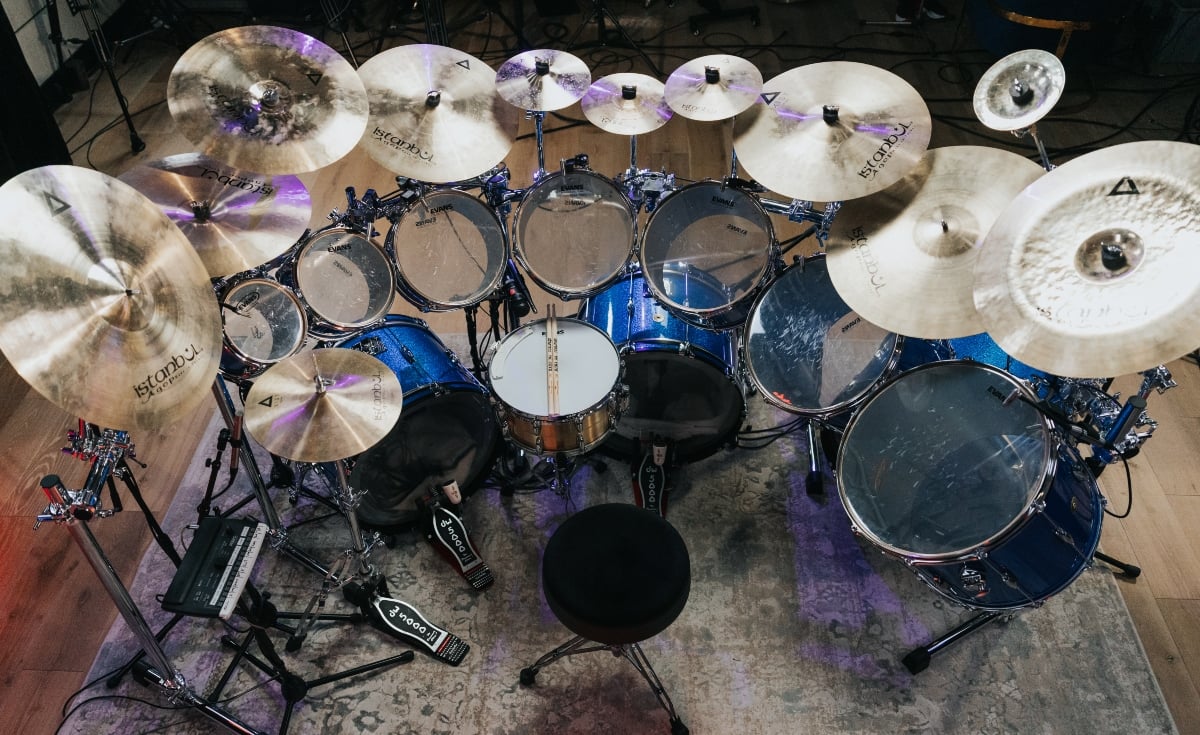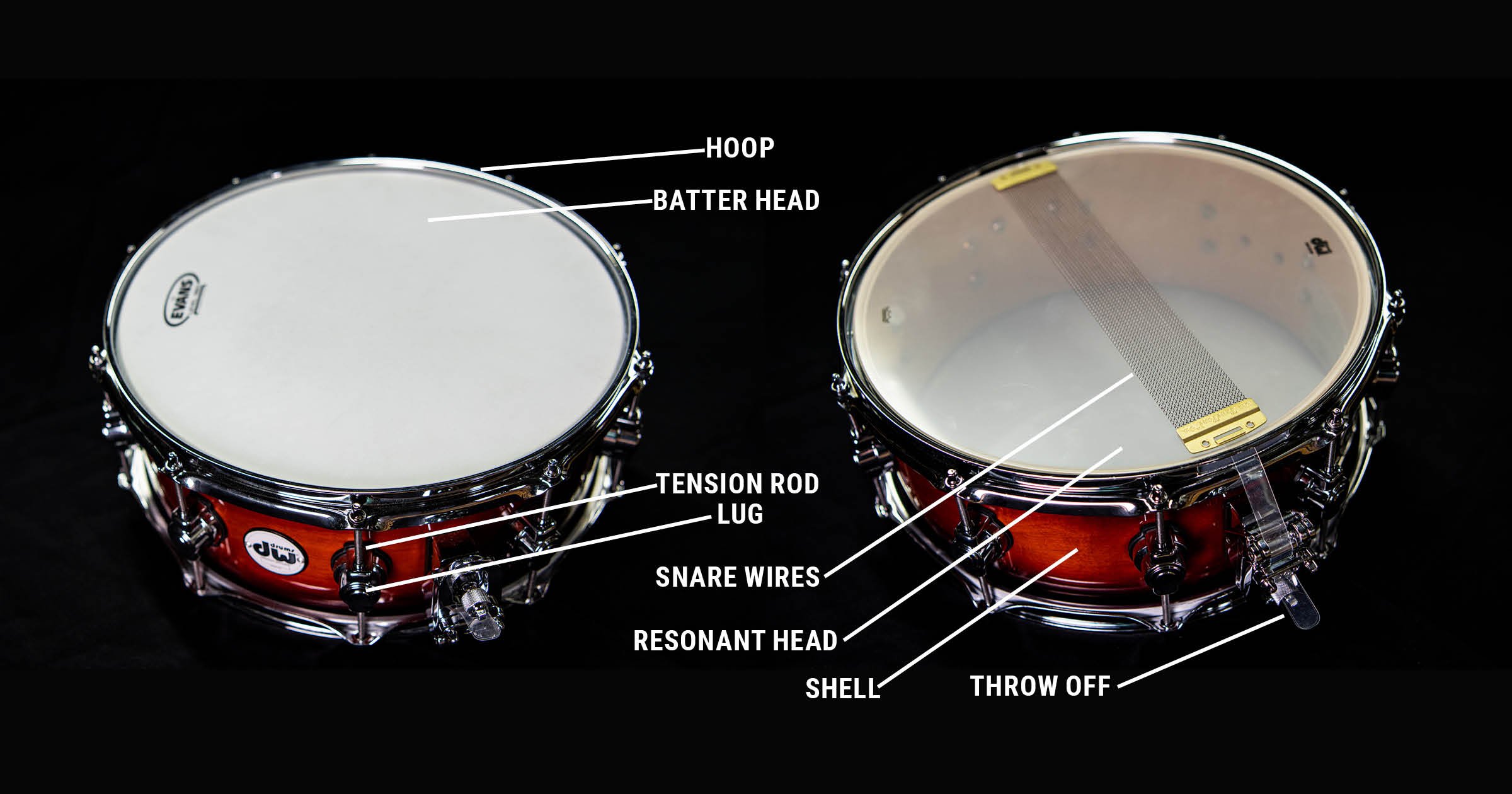
Whether you prefer the term ‘drum set’ or ‘drum kit,’ the beauty is that you can set it up in whatever configuration you like. There’s no formula – no right or wrong – as long as it’s comfortable to play!
In this quick and easy guide, we’ll look at the drums, cymbals, hardware, and accessories that combine to make the sum greater than the parts. Let’s check out the tools of your trade.

The drums and cymbals that make up the kits we recognize today were once only played as separate instruments in military bands and orchestras. In the mid-1800s, percussionists began combining drums and cymbals so they could play multiple pieces at the same time.
By the turn of the century, with the invention of pedals, the drum kit as we know it started to take shape. The kits became known as “contraption kits,” shortened to “traps.” We still use that term to describe certain hardware cases these days.
Warren “Baby” Dodds, a Trap kit pioneer
Let’s focus on the most common parts of the kit you’ll be playing. The heartbeat of the drum set is the snare drum, bass drum, and toms.

The snare drum, also known as a side drum (historically, it hung to a marching drummer’s hip), is the cornerstone of the drum set and sits right in front of you. Crucially, a set of snare wires runs along the resonant bottom head, acting as the defining element of its sound. When struck with drumsticks or brushes, the wires beneath the bottom head vibrate, creating a characteristic sharp, staccato sound—often called the drum’s “crack” or “snap.” The wires are adjustable and significantly affect the sound, depending on how tight or loose they are, controlled by a throw-off on the side of the drum. Snares are typically 14″ in diameter with a depth of 3″ to 8″, generally speaking. A standard size would be 14″ x 5″.

The bass drum (also called the kick, as it’s played with a foot pedal) is a core element in the drum set. It contrasts the snare’s sharpness with its deep, resonant boom.
Typically the biggest drum in the set, it produces a low sound that anchors the rhythms you play. Some drummers place pillows or towels inside it to dampen the sound, which can be boomy or ringy due to the large size of the drum.

Toms, or tom-toms, come in various sizes and can be positioned in different ways around the kit. Rack toms, smaller in size, typically sit above the bass drum, while floor toms, bigger and deeper, are placed at the drummer’s side. A standard five-piece drum kit will have two rack toms and one floor tom. Their diverse sizes result in varied pitches—the smaller toms produce higher, more distinct sounds, while the larger ones create deeper, fuller tones.
See those numbers in the diagram? They specify the diameter and the depth of the drum. You can read more about drum specs here.
The diameter of the drum affects the pitch, which is why a big bass drum sounds lower than a small tom. The depth affects the resonance, which means a shorter drum will have more attack and less ring, and a deeper drum will be more “boomy.”
The bigger and deeper the shell, the thicker and lower the tone. A smaller and shallower shell means lighter and brighter.

Cymbals are the metal alloy discs in a drum set, typically made from bronze. Placed on stands, they add different tones and accents to complement the drums.
The most common types of cymbals you’ll find in your average drum set are hi-hats, crash cymbals, and a ride cymbal.
Hi-Hats
The hi-hat cymbals consist of two matching cymbals positioned face-to-face on a stand with a foot pedal. You use a piece of hardware called a clutch to connect the top cymbal to the stand.
When closed, they produce a distinct note played with the stick or the foot. The pedal lets you bring them together for a tighter sound or open them up for a looser, louder feel.
Hi-hats are on the smaller side compared to other cymbals, with the exception of the splash cymbal (a small effect cymbal).
Crash cymbals
Crashes come in a variety of sizes (16″-20″ are the most common) and are known for their explosive, high-pitched sound. Unlike the hi-hat and ride cymbals, which drummers use to maintain the beat, this cymbal is often used to emphasize or punctuate specific exciting moments or transitions in a musical piece.
You can keep the pulse (also known as “riding”) on a crash cymbal as well, but unless you play rock or metal, you might find it too overpowering for the music.
Ride cymbals
The ride, typically the largest cymbal on a drum kit, produces a medium-to-high pitched sound. Like hi-hats, their primary role is maintaining a steady rhythm over a beat, though by laying into the edge you can also use them like big crashes.
In addition to the above, splashes are the smallest cymbals in the kit with a loud, sharp, short-lived sound, and a China is a distinct effect cymbal with an explosive and low-pitched sound, usually mounted upside down.

Drum set hardware are the stands and mounts holding drums and cymbals (remember the contraptions we mentioned earlier!?). Boom stands extend horizontally, providing versatility in positioning cymbals, while upright stands offer stability for floor toms or additional cymbals. Snare stands are baskets that can also be used to hold a tom, and hi-hat stands control the movement and positioning of the hi-hat cymbals with a pedal. Drum manufacturers are constantly exploring new ways of mounting drums to sound better or improve our setups; there are often new gadgets and add-ons to hold a cowbell, laptop, splash cymbal, or drink!
Bass drum pedal

The bass drum pedal is a key piece of the drum set. When pressed, the pedal activates a beater that strikes the bass drum for deep, resonant tones that lay the rhythm’s foundation. Most pedals have adjustable tensions and changeable beaters to achieve different sounds and complement your playing technique.
There’s no strict formula for setting up your drums, but there are definitely some best practices:
Depending on your body and music preferences, certain configurations and sizes will work best for you. From the snare’s sharp crack to the bass drum’s boom, you’ll decide what you want to reflect your style and preferences.
Embrace the freedom to curate your kit and choose drums and cymbals you’ll love to play!
Drumeo Team - We're professional, award-winning drummers and drum teachers, coaches, recording artists, and content specialists who are passionate about drums and helping drummers around the world. This post was written and/or edited by Sam Landa, Brandon Toews, Jared Falk, Dave Atkinson, or another pro on our team (which has a combined 1000+ years of drumming experience). Are you looking for inspiration, education, and support to take your playing to the next level? Join the Drumeo community today!


By signing up you’ll also receive our ongoing free lessons and special offers. Don’t worry, we value your privacy and you can unsubscribe at any time.
We use cookies for traffic data and advertising. Cookie Policy »